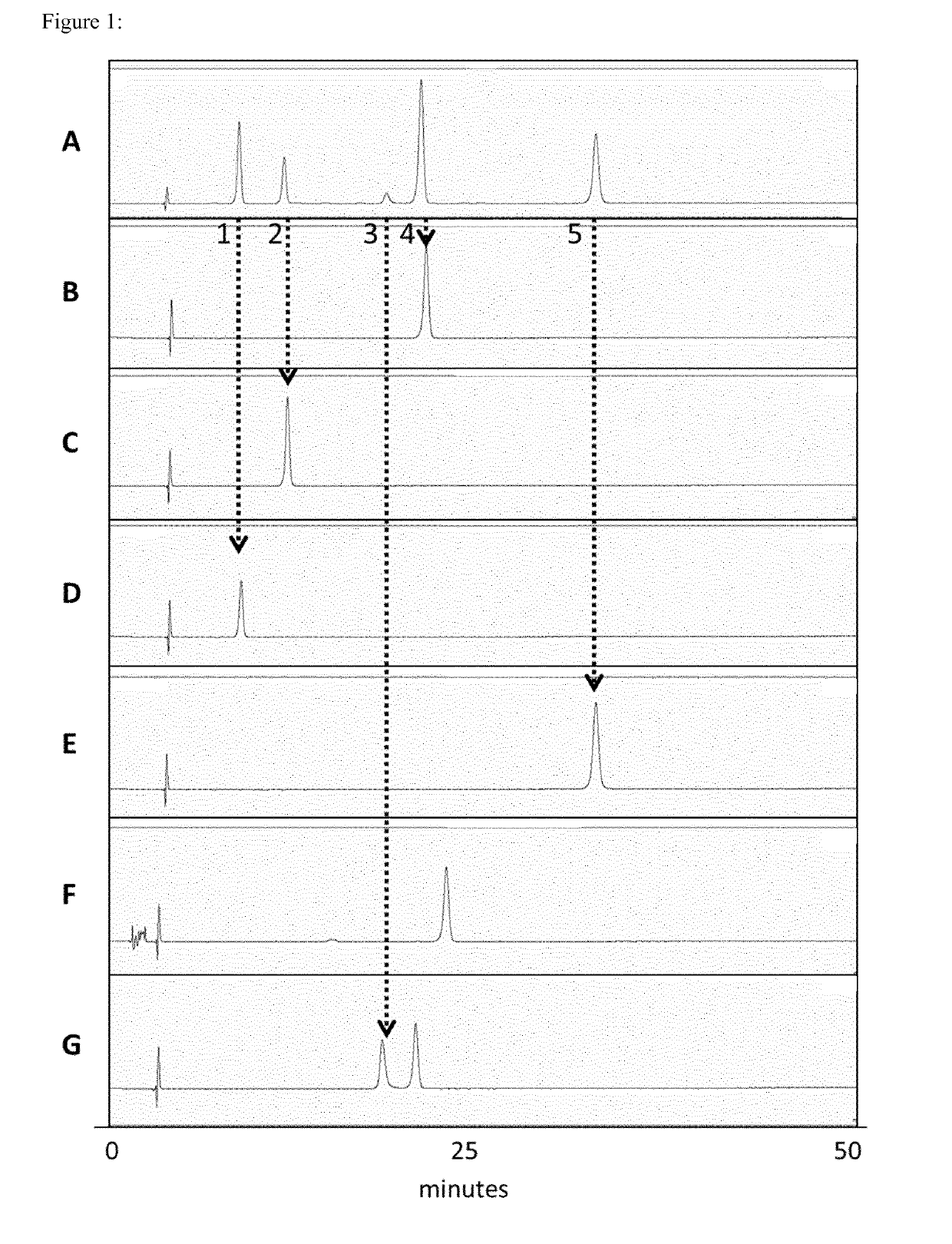RNA analysis by total hydrolysis
a total hydrolysis and analysis method technology, applied in the field of rna analysis, can solve the problems of translation errors and no all-encompassing quality control, and achieve the effect of powerful quality control
- Summary
- Abstract
- Description
- Claims
- Application Information
AI Technical Summary
Benefits of technology
Problems solved by technology
Method used
Image
Examples
example 1
on of the mRNA
1. Preparation of DNA and mRNA Constructs
[0857]For the present example, DNA sequences encoding mRNA of Photinus pyralis luciferase (PpLuc, R2988), three human cancer antigens (HsPSCA, R1871; HsNY-ESO-1, R1857; Hs5T4, R1855) and Rabies virus glycoprotein (RAV-G, R1803) were generated. The DNA sequences were prepared by modifying the wild type encoding DNA sequence to optimize the GC-content for stabilization. The DNA sequence was introduced into a pUC19 derived vector and modified to comprise an alpha-globin-3′-UTR (muag (mutated alpha-globin-3′-UTR)), a histone-stem-loop structure, and a stretch of 70×adenosine at the 3′-terminal end (poly-A-tail). The obtained plasmid DNA was used for RNA in vitro transcription experiments to obtain respective mRNA (SEQ ID NO. 1-5).
2. RNA In Vitro Transcription
[0858]The DNA plasmids prepared according to paragraph 1 were transcribed in vitro using T7 polymerase. All mRNAs were capped by co-transcriptional capping, using a cap analogue...
example 2
rolysis of RNA
[0863]The goal of this experiment was to enzymatically hydrolyze mRNA species obtained according to Example 1 to obtain the single nucleosides of each of the mRNA species. The obtained nucleoside mixtures were used for further analysis using HPLC (see Example 3).
Enzymatic Hydrolysis of mRNA
[0864]mRNA was completely hydrolysed by the action of three types of hydrolases. Phosphodiesterase I from Crotalus adamanteus (SvP) and Nuclease P1 from Penicillium citrinum (P1) were obtained as dried powder from Sigma Aldrich. SvP was dissolved to 0.5 U / ml in 110 mM Tris-HCl buffer, pH 8.9, 100 mM NaCl, 15 mM MgCl2, 50% Glycerol and stored at −20° C. P1 was dissolved to 1 g / L in 20 mM sodium acetate buffer pH 5.3, 5 mM ZnCl2, 50 mM NaCl, 50% Glycerol and stored at −20° C. Shrimp alkaline phosphatase (AP) was obtained from New England Biolabs.
[0865]60 μg of each mRNA was hydrolysed first for 2 h at 42° C. with 0.3 μg of P1 in 33 mM ammonium acetate buffer pH 5.3 supplemented with 2....
example 3
ysis of the Hydrolysed mRNA
[0866]The goal of this experiment was to analyse each nucleoside mixture obtained via total mRNA hydrolysis (see Example 2) by HPLC to gain information about the matching of the sequence with the expected sequence, the matching of the length with the expected length, the capping efficiency, the incorporation rate of modified nucleosides (8-OH-G), oxidation and the length of the poly(A) stretch of each hydrolysed mRNA.
[0867]This inventive method can be used as a multifaceted quality control of in vitro transcribed mRNA.
1. HPLC Analysis of Nucleosides
[0868]Samples obtained via total hydrolysis (see Example 2) were separated using a commercially available HPLC setup. In essence, an octadecyl capped silica column (YMC*Gel ODS-A-HG, pore size: 300 A, particle size: 10 μm, dimensions (IDxh) 250 mm×4.6 mm, YMC) in a linear gradient from 100% Buffer A (5 mM NH4OAc pH 6) to 20% Buffer B (40% v / v acetonitrile) was used for the separation of nucleosides in the hydrol...
PUM
| Property | Measurement | Unit |
|---|---|---|
| pH | aaaaa | aaaaa |
| length | aaaaa | aaaaa |
| HPLC | aaaaa | aaaaa |
Abstract
Description
Claims
Application Information
 Login to View More
Login to View More - R&D
- Intellectual Property
- Life Sciences
- Materials
- Tech Scout
- Unparalleled Data Quality
- Higher Quality Content
- 60% Fewer Hallucinations
Browse by: Latest US Patents, China's latest patents, Technical Efficacy Thesaurus, Application Domain, Technology Topic, Popular Technical Reports.
© 2025 PatSnap. All rights reserved.Legal|Privacy policy|Modern Slavery Act Transparency Statement|Sitemap|About US| Contact US: help@patsnap.com



